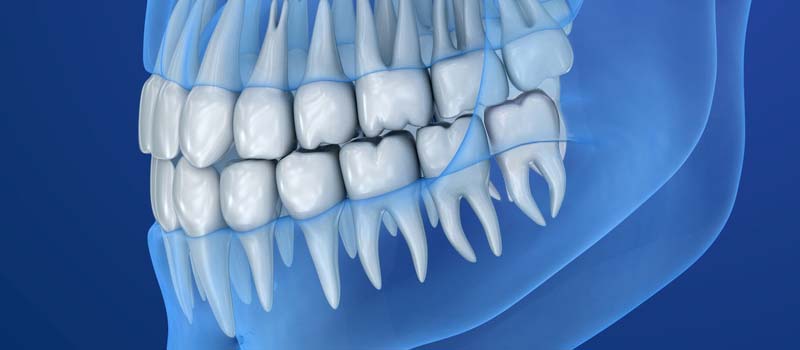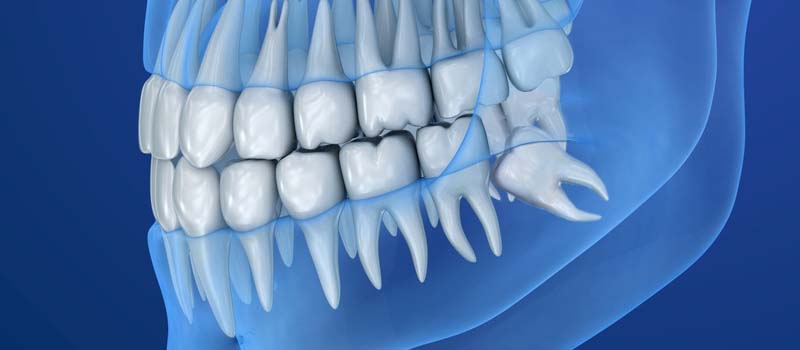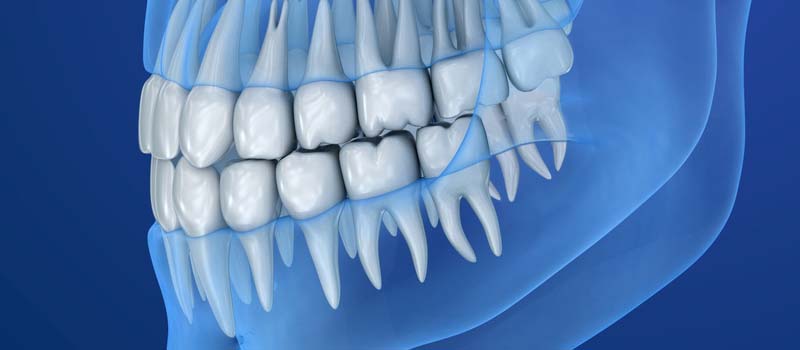Teeth Cleanings | Fillings | Crowns & Bridges | Tooth Extractions
 Our practice can provide a wide range of dental services. We can typically provide every type of dental service without having to refer you to other specialties. This flexibility saves you time and keeps your total dental care within one practice. Our emphasis is on total preventive care for our patients. Total care begins with regular hygiene visits, regular check-ups and continued home oral health routines.
Our practice can provide a wide range of dental services. We can typically provide every type of dental service without having to refer you to other specialties. This flexibility saves you time and keeps your total dental care within one practice. Our emphasis is on total preventive care for our patients. Total care begins with regular hygiene visits, regular check-ups and continued home oral health routines.
Our practice also provides the highest-quality services for restoring mouths that have been damaged by dental disease and injury and common problems that require cosmetic dentistry. Our primary goal for our patients is to achieve and maintain optimum oral health through advances in techniques, technologies and by maintaining their scheduled dental exams.
Teeth Cleanings
Twice a year, you should schedule a routine dental cleaning. At this visit, one of our dental hygienists will thoroughly remove plaque from your teeth, especially from places where your toothbrush can't reach, such as underneath the gum line and in-between teeth. We will then clean your teeth and apply fluoride to help prevent decay.
Fluoride is a fairly recent but important advancement in dental and oral health. Studies consistently demonstrate that a moderate but consistent exposure of teeth to fluoride helps strengthen and rebuild tooth enamel, and thus prevent cavities.
If you are due for your dental cleaning, please call our office to schedule an appointment.
Fillings
The concept of a "filling" is replacing and restoring tooth structure that is damaged due to decay or fracture with a material. We can replace old, broken-down amalgam/metal fillings that contain traces of mercury with white fillings (composites) to restore your smile and teeth to a more natural look and feel.
With today's advancements, no longer will you have to suffer the embarrassment of unsightly and unhealthy silver/mercury fillings or metal margins of the past. Eliminate the dark, black appearance in your teeth with new-age, state-of-the-art, tooth-colored resin or porcelain materials.
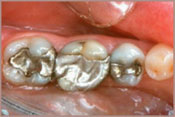
BEFORE
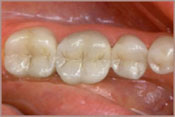
AFTER
Crowns and Bridges
Crowns
A crown is a custom-made covering that fits over an original tooth that is either decayed, damaged or cracked. Crowns are made of a variety of different materials such as porcelain, gold, acrylic resin or a mix of these materials. Porcelain generally has the most natural appearance.
The treatment plan for a patient receiving a crown involves:
- Numbing the tooth to remove the decay in or around it.
- Re-sculpturing the tooth to provide an ideal fit for the crown.
- Making an impression of your teeth in order to create a custom-made crown (usually takes one to two weeks).
- Making a temporary crown out of acrylic resin and fitting it onto the tooth during the interim period when the custom-made crown is being created.
- Applying the custom-made crown (when received from the lab) by removing the temporary crown and fitting the custom-made one onto the tooth.
- After ensuring that the crown has the proper look and fit, the dentist cements it into place.
This process generally consists of a minimum of two to three visits over a three to four week period. Once the procedure is completed, proper dental hygiene, including daily brushing and flossing, is required to maintain healthy, bacteria-free teeth, gums and crowns. This helps in the prevention of gum disease. Given proper care, your crowns can last a lifetime.
Crowns

When a tooth is fractured or has large, old fillings, it might need to be replaced with a crown. A crown is a custom-made cap that completely covers an original tooth.

The tooth will be numbed using a local anesthetic.

The doctor removes the decay and re-sculpts the tooth so that the crown can be placed on top of it.

The doctor will take an impression of the new shape of the tooth. That impression will be sent to a lab, where the permanent crown will be custom-made.

A temporary crown is made out of acrylic resin and fitted on the tooth during the interim period.

At the next appointment, the doctor will remove the temporary crown and fit the custom crown onto the tooth. After ensuring that the custom crown has the proper look and fit, the doctor will cement it into place.
Bridges
A bridge is a dental device that fills a space that a tooth previously occupied. A bridge may be necessary to prevent:
- Shifting of the teeth that can lead to bite problems (occlusion) and/or jaw problems and resultant periodontal disease.
- Bridges safeguard the integrity of existing teeth and help maintain a healthy, vibrant smile.
There are three main types of bridges, namely:
- A fixed bridge is the most popular and consists of a filler tooth that is attached to two crowns, which fit over the existing teeth and hold the bridge in place.
- The "Maryland" bridge is commonly used to replace missing front teeth and consists of a filler that is attached to metal bands that are bonded to the abutment teeth. The metal bands consist of a white-colored composite resin that matches existing tooth color.
- The cantilever bridge is often used when there are teeth on only one side of the span. A typical three-unit cantilever bridge consists of two crowned teeth positioned next to each other on the same side of the missing tooth space. The filler tooth is then connected to the two crowned teeth, which extend into the missing tooth space or end.
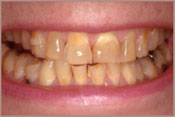
BEFORE
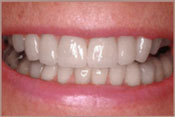
AFTER
Tooth Extractions
General Extractions
An extraction is the complete removal of a tooth. Extractions are sometimes necessary if a primary tooth is preventing the normal eruption of a permanent tooth, if the tooth has suffered extensive tooth decay or trauma that cannot be repaired, if the patient has gum disease, or if the tooth is impacted (usually the wisdom teeth). Depending on the complexity of the case, an extraction can be performed surgically or non-surgically. A mild anesthesia is used to ensure you or your child is as comfortable as possible throughout the procedure.
Wisdom Teeth
Your third molars are more commonly called "wisdom teeth." Usually appearing in the late teens or early twenties, third molars often lack the proper space in the jaw to erupt fully or even at all. This common condition is called impaction. When any tooth lacks the space to come through or simply develops in the wrong place of your jaw and becomes impacted, problems can arise. Primarily, damage to adjacent teeth and crowding occur.
In certain cases, the wisdom tooth that cannot come through becomes inflamed under the gums and in the jawbone, causing a sac to develop around the root of the tooth that then fills with liquid. This can cause a cyst or an abscess if it becomes infected. If either of these situations goes untreated, serious damage to the underlying bone and surrounding teeth and tissues can result.
To potentially stave off this result, an extraction of one, several or all of the wisdom teeth may be advised. If that is the case, we have the equipment and training needed to perform such extractions, with an absolute minimum of discomfort. Ask our staff for more information regarding tooth extractions if you feel you may need one.


